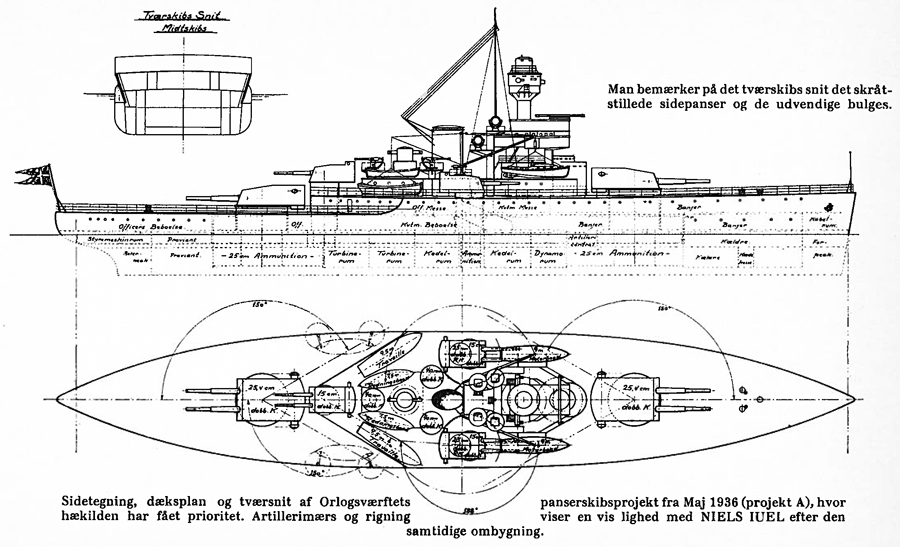Rebuilding the Navies:
The first decision to be made on having made peace was to rebuild the Navies of the three protagonists.
Lessons had been learned and all realized now the Swedes too that quickfire artillery was a must as was good steel armour. Days of deck or compound armour was over. Though it would be costly it would also secure orderbooks for ship yards and jobs for workers.
The Danes and Norwegians understood that they needed larger ships if they were to go on blockade again. The living quarters left much to be desired though the Olfert Fischer class wasn't bad. It just needed enlargement.
Of course the other Danish issue was that Cruisers were still needed. The Elswick Cruiser had shown itself not to be a Ship of the line so these could not be factored into the numbers of ships weighed against the possible enemy. For distant blockade yes – in battle against more armoured opponents no.
Valkyrien had taken heavy punishment its deckarmour pierced and the mini-Elswicks wouldn't have survived the battle.
Frederikshavn as a depot seemed the only real thing; it would also serve to strengthen communications with Norway. And provide a large shipyard to Norway within reasonable distance though on Danish ground.
H V Buhls Steelship Yard would thrive in years to come.
This would also necessiate real base facilities like barracks and storage for provisions and ammunition.
Regarding ammunition there was something of a problem. Almost all 9,4”, 6” and 57mm had been fired and needed replenishment. Also quite a few barrels had come close to being worn out and had to be replaced.
Due to damage quite a number of guns and other ship parts had to be replaced or ships wholly rebuilt or scrapped.
Swedish Submarine Hajen had been a most genuine threat in being and countermeasures had to be made like buying some.
The ships would need more armour below the waterline to counter torpedoes. Though the main defences against Submarines would still be speed and range until some detection device would invented.
Submarines would be needed in future conflicts.
There were positives too; Norway lacking a Naval Yard was very interested in shared financing Frederikshavn or be party to Copenhagen Naval Yard. The ideal position would be a Naval Yard in Norway but the Norwegians also wanted to economize on expenditure though it meant fewer jobs in Norway but then less leftwing leaning workers demanding all sorts of luxuries.
With the defense treaty signed that would only be a question of time. Both countries needed to be able to fend for themselves in case of another conflict.
The added bonus being familiarization of the two Navies.
The problem by now was where to find new big guns.
Krupp had been a regular supplier to Denmark but Bofors of Sweden had been a major supplier of quickfiring guns as of lately. At the moment Sweden wasn't really into selling arms to its former opponents.
Some guns could be produced locally but a supplier would be needed mostly because of the ongoing development of guns and gunpowder. The natural supplier would be the power that had supported the alliance namely Britain.
Captain Kofoed-Hansen was of the opinion that the two ordered vessels of the Herluf Trolle class would still be built though the design would need change.
Instead of the two single maingun turrets they would get three twin turrets and the secondary and tertiary guns would be changed to a single calibre in single turrets.
The main turrets would become an A – X – Y configuration with two turrets to the rear. This wasn't deemed a detriment as the main engagement had been mainly by broadsides firing.
Both Herluf Trolle and Olfert Fischer were to be repaired but would undergo changes to their secondary and tertiary guns which would be replaced by a single calibre guns and placed in single turrets. New main guns would have to be procured too.
(There was changes to the design of Armoured Costal Artilleryship Niels Iuel which began as another Olfert Fischer class ship which ended up quite different. During the build process there was a plan to redesign it as a three double turret ship with an A – X – Y placement like this 1938 study

Valkyrien would be refitted with new quick-firing guns replacing her old artillery and new engines to increase speed.
Side armour to protect the machinery would be considered based on the Göteborg experience though higher speed might be a better precaution; this would have to be considered with the future role of the ship as a unit to show the Flag in far away West Indies. Valkyrien never should have been at that battle though she did serve well.
Ivar Hvitfeldt would be scrapped. The old ship had been almost wrecked during the battle and only beaching had saved it from sinking. It had been able though to take a lot of punishment during the battle and its crew would sorely miss it.
The operational life of the majority of the armoured ships had to be considered.
None except Skjold would have survived the battle of Göteborg.
The three mini-Elswicks had to have their future considered too. They were simply too small for their intended role or rather too heavily armed for fishery inspection in the North Atlantic.
In all ten or eleven major units of the Navy had to be sold scrapped or replaced. The procurement of new artillery might make it possible to operate fewer more capable ships in the future.
Then there was the need to acquire Submarines!








